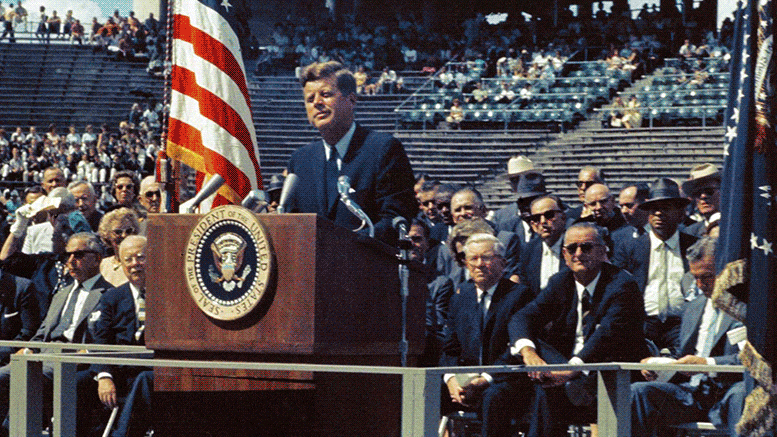Evento histórico para vuelo espacial tripulado, nueva fecha de lanzamiento de Artemis I
4 min read
Conmemorando un evento histórico para los vuelos espaciales tripulados…
“Nosotros elegimos ir a la luna…”
Una actualización de los planes para Artemisa I …
Y qué El rover Perseverance de la NASA está a la altura[{” attribute=””>Mars … a few of the stories to tell you about – This Week at NASA!
El 60 aniversario del discurso de JFK en la Universidad de Rice
El 12 de septiembre, la NASA y la Universidad Rice conmemoraron el 60 aniversario de Discurso histórico de John F. Kennedy a Rice en 1962. En ese discurso, el presidente volvió a comprometer a la nación con el objetivo que propuso al Congreso en mayo de 1961 de llevar astronautas a la Luna antes del final de la década y devolverlos a salvo a la Tierra. Como señaló el administrador de la NASA, Bill Nelson, durante los comentarios de apertura del evento, el discurso del presidente ayudó a avanzar en nuestro liderazgo en los vuelos espaciales tripulados en ese momento, y continúa inspirándonos hoy mientras nos esforzamos por devolver a los humanos a la Luna y, eventualmente, a Marte. como parte del programa Artemis de la NASA.
“Hace 60 años, el presidente Kennedy puso el viento en nuestras velas en el nuevo mar de la exploración espacial y esta misión no tiene fin. Es una misión sobre la ciencia y el avance del espíritu humano para expandir lo que es posible”. — Bill Nelson, administrador de la NASA

La representación de este artista muestra una vista aérea del despegue del cohete Space Launch System (SLS) de la NASA. La configuración de la tripulación del Bloque 1 de este cohete enviará las tres primeras misiones Artemis a la Luna. Crédito: NASA/MSFC
Nuevas fechas previstas para las pruebas y el lanzamiento de Critical Artemis I
Una prueba de demostración criogénica para nuestro no equipado La prueba de vuelo de Artemis I ahora está dirigida Miércoles 21 de septiembre como muy pronto. Mientras tanto, la agencia ha solicitado una oportunidad de lanzamiento el 27 de septiembre para el Sistema de lanzamiento espacial, o[{” attribute=””>SLS rocket and Orion spacecraft, with a potential backup opportunity of October 2 under review. During the cryogenic demonstration, teams will load super cold liquid oxygen and liquid hydrogen into the core stage and interim cryogenic propulsion stage of the SLS to confirm that a hydrogen leak has been fixed. Artemis I is the first integrated flight test with the SLS and Orion. The mission will send Orion beyond the Moon and return the spacecraft back to Earth.

NASA’s Perseverance rover puts its robotic arm to work around a rocky outcrop called “Skinner Ridge” in Mars’ Jezero Crater. Composed of multiple images, this mosaic shows layered sedimentary rocks in the face of a cliff in the delta, as well as one of the locations where the rover abraded a circular patch to analyze a rock’s composition. Credit: NASA/JPL-Caltech/MSSS
Perseverance Rover Investigates Geologically Rich Mars Terrain
NASA’s Perseverance rover is collecting samples and analyzing the composition of rocks at an ancient river delta located in the Red Planet’s Jezero Crater, an area long considered by scientists to be a top prospect for finding signs of possible ancient microscopic life. In its analysis of a sample from a rock named Wildcat Ridge, the rover’s SHERLOC instrument registered the most abundant organic detections on the mission to date. Further conclusions about what is contained in this sample will have to wait until it’s returned to Earth for in-depth study as part of the Mars Sample Return campaign, an international collaboration led by NASA and the European Space Agency.

Dr. Thomas Zurbuchen, the associate administrator for NASA’s Science Mission Directorate. Credit: NASA
NASA Announces Pending Departure of Science Associate Administrator
Dr. Thomas Zurbuchen, the associate administrator for NASA’s Science Mission Directorate, is planning to leave the agency at the end of 2022. His six years at NASA have included some of the agency’s most inspirational moments, from sending the first spacecraft to touch the Sun, to launching and sharing the first images from the James Webb Space Telescope, to landing the Perseverance rover on Mars along with the Ingenuity helicopter that went on to make the first powered, controlled flight on another planet. The agency is conducting a nationwide search and open competition for a new associate administrator.

This artist’s concept of NASA’s QueSST jet reflects the airplane’s final configuration following years of research and design engineering. Credit: Lockheed Martin
Ground Recording Stations Tested for Future Quiet Supersonic Flight
The team at NASA’s Armstrong Flight Research Center recently completed a flight series called CarpetDIEM which tested state-of-the-art ground recording stations designed to hear and record the unique sounds that will be generated during future supersonic flights by NASA’s X-59 aircraft. The X-59’s goal is to reduce the intensity of sonic booms, which are heard when an aircraft flies faster than the speed of sound, to a quiet sonic “thump.” When the X-59 flies, NASA will record the sonic thumps as part of the effort to validate its quiet supersonic design.
That’s what’s up this week @NASA …

“Increíble aficionado a la música. Estudiante. Empollón empedernido del café. Jugador. Especialista web aficionado. Pionero malvado de la cultura pop”.


